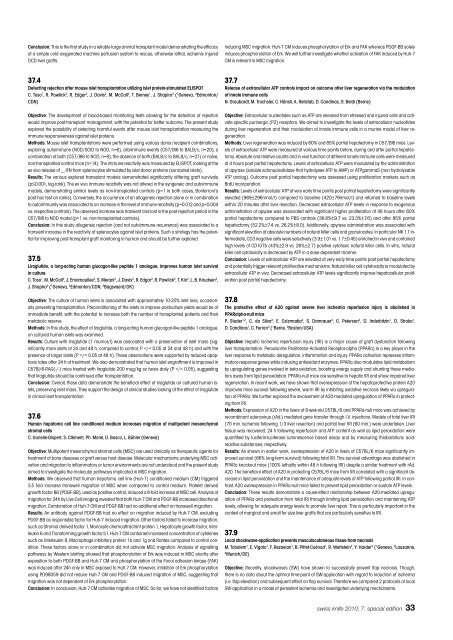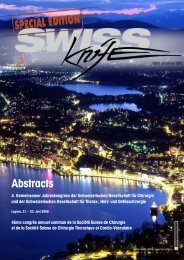Anorectal Manometry in 3D NEW! - Swiss-knife.org
Anorectal Manometry in 3D NEW! - Swiss-knife.org
Anorectal Manometry in 3D NEW! - Swiss-knife.org
Create successful ePaper yourself
Turn your PDF publications into a flip-book with our unique Google optimized e-Paper software.
Conclusion: This is the first study <strong>in</strong> a reliable large animal transplant model demonstrat<strong>in</strong>g the efficacy<br />
of a simple cold oxygenated mach<strong>in</strong>e perfusion system to rescue, otherwise lethal, ischemic <strong>in</strong>jured<br />
DCD liver grafts.<br />
37.4<br />
Detect<strong>in</strong>g rejection after mouse islet transplantation utiliz<strong>in</strong>g islet prote<strong>in</strong>-stimulated ELISPOT<br />
C. Toso 1 , R. Pawlick 2 , R. Edgar 2 , J. Davis 2 , M. McCall 2 , T. Berney 1 , J. Shapiro 2 ( 1 Geneva, 2 Edmonton/<br />
CDN)<br />
Objective: The development of blood-based monitor<strong>in</strong>g tests allow<strong>in</strong>g for the detection of rejection<br />
would improve post-transplant management, with the potential for better outcome. The present study<br />
explored the possibility of detect<strong>in</strong>g harmful events after mouse islet transplantation measur<strong>in</strong>g the<br />
immune responsiveness aga<strong>in</strong>st islet prote<strong>in</strong>s.<br />
Methods: Mouse islet transplantations were performed us<strong>in</strong>g various donor/recipient comb<strong>in</strong>ations,<br />
explor<strong>in</strong>g autoimmune (NOD/SCID to NOD, n=6), alloimmune events (C57/Bl6 to BALB/c, n=20), a<br />
comb<strong>in</strong>ation of both (C57/Bl6 to NOD, n=8), the absence of both (BALB/c to BALB/c, n=21) or naïve,<br />
non-transplanted control mice (n=14). The immune reactivity was measured by ELISPOT, look<strong>in</strong>g at the<br />
ex vivo release of _ ;IFN from splenocytes stimulated by islet donor prote<strong>in</strong>s (sonicated islets).<br />
Results: The various explored transplant models demonstrated significantly differ<strong>in</strong>g graft survivals<br />
(p≤0.001, log-rank). The ex vivo immune reactivity was not altered <strong>in</strong> the syngeneic and autoimmune<br />
models, demonstrat<strong>in</strong>g similar levels as non-transplanted controls (p=1 <strong>in</strong> both cases, Bonferroni’s<br />
post-hoc test on ranks). Conversely, the occurrence of an allogeneic rejection alone or <strong>in</strong> comb<strong>in</strong>ation<br />
to autoimmunity was associated to an <strong>in</strong>crease <strong>in</strong> the level of immune reactivity (p=0.012 and p=0.004<br />
vs. respective controls). The observed <strong>in</strong>crease was transient and lost <strong>in</strong> the post-rejection period <strong>in</strong> the<br />
C57/Bl6 to NOD model (p=1 vs. non-transplanted controls).<br />
Conclusion: In this study allogeneic rejection (and not autoimmune recurrence) was associated to a<br />
transient <strong>in</strong>crease <strong>in</strong> the reactivity of splenocytes aga<strong>in</strong>st islet prote<strong>in</strong>s. Such a strategy has the potential<br />
for improv<strong>in</strong>g post-transplant graft monitor<strong>in</strong>g <strong>in</strong> human and should be further explored.<br />
37.5<br />
Liraglutide, a long-act<strong>in</strong>g human glucagon-like peptide 1 analogue, improves human islet survival<br />
<strong>in</strong> culture<br />
C. Toso 1 , M. McCall 2 , J. Emamaullee 2 , S. Merani 2 , J. Davis 2 , R. Edgar 2 , R. Pawlick 2 , T. K<strong>in</strong> 2 , L. B. Knudsen 3 ,<br />
J. Shapiro 2 ( 1 Geneva, 2 Edmonton/CDN, 3 Bagsvaerd/DK)<br />
Objective: The culture of human islets is associated with approximately 10-20% islet loss, occasionally<br />
prevent<strong>in</strong>g transplantation. Precondition<strong>in</strong>g of the islets to improve postculture yields would be of<br />
immediate benefit, with the potential to <strong>in</strong>crease both the number of transplanted patients and their<br />
metabolic reserve.<br />
Methods: In this study, the effect of liraglutide, a long-act<strong>in</strong>g human glucagon-like peptide 1 analogue,<br />
on cultured human islets was exam<strong>in</strong>ed.<br />
Results: Culture with liraglutide (1 mumol/l) was associated with a preservation of islet mass (significantly<br />
more islets at 24 and 48 h, compared to control; P
















